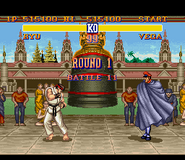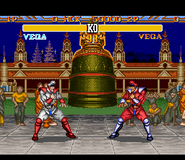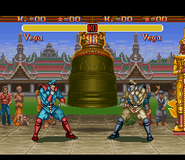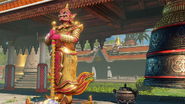Temple Hideout, originally known as Ramayana Temple (ラーマーヤナ寺院 Rāmāyana Jiin?), is M. Bison's stage in the Street Fighter II series. The stage is set in Shadaloo's secret base in Thailand, in a temple with a bell and two breakable statues.
Description
Street Fighter II

Ramayana Temple in Super Street Fighter II.
The bell rings, indicating the start of the fight, and people gathered to watch it. Someone challenged M. Bison to a fight. It doesn't matter for Bison the challenger's motives, be it for a grudge against him or simply to test his strength, in the end of the battle the challenger will understand Bison's true power at the cost of his life. Bison takes off his cape, showing that he will fight without restraint.[1] The match becomes an one-sided massacre as the challenger is overwhelmed by M. Bison's Psycho Power, Bison having an evil smile as he pummels his opponent. Despite the odds, the challenger is determined to win, giving his best in the battle.[2]
Akuma is also fought in this stage when reached as a secret boss in some versions of the game.
Street Fighter V
The stage returns as a DLC stage named Temple Hideout. Notable differences include moving the statues closer to the large bell and they no longer break when an opponent is slammed near them.
Other appearances

The temple in Worlds Unite
In the Archie Comics crossover Worlds Unite, M. Bison destroyed Blizzard Buffalo when the later attempted to set an Unity Engine in the temple, learning from him about Sigma's plans and gathering the Four Kings to face the one that dared to invade "his" world.
Trivia
- Temple Hideout was first released on April 25th, 2017 but was previously disabled by Capcom due to the irrelevant Islamic chants that plays during its theme.[citation needed]
- For those who had bought the stage before the ban, M. Bison's theme would play instead.
- This makes Temple Hideout the first and only stage to be previously banned due to its stage theme.
- This isn't the first time that the chants themselves were heard from within a video game. The same chants could be heard in Cruis'n World, a racing game for the arcades released in 1996, Kakuto Chojin: Back Alley Brutal, another fighting game released for the XBox in 2002 and The Legend of Zelda: Ocarina of Time, released in 1998 for the Nintendo 64. Ocarina of Time's fire temple had these voice samples in its music. Later versions of the game do not feature these samples.
- The voice samples come from a sound library called Voice Spectral: Volume 1.
Gallery
References
- ↑ Eiga Street Fighter II Memorial Kōshiki Fanbook (translation)
- ↑ Street Fighter II Complete File





